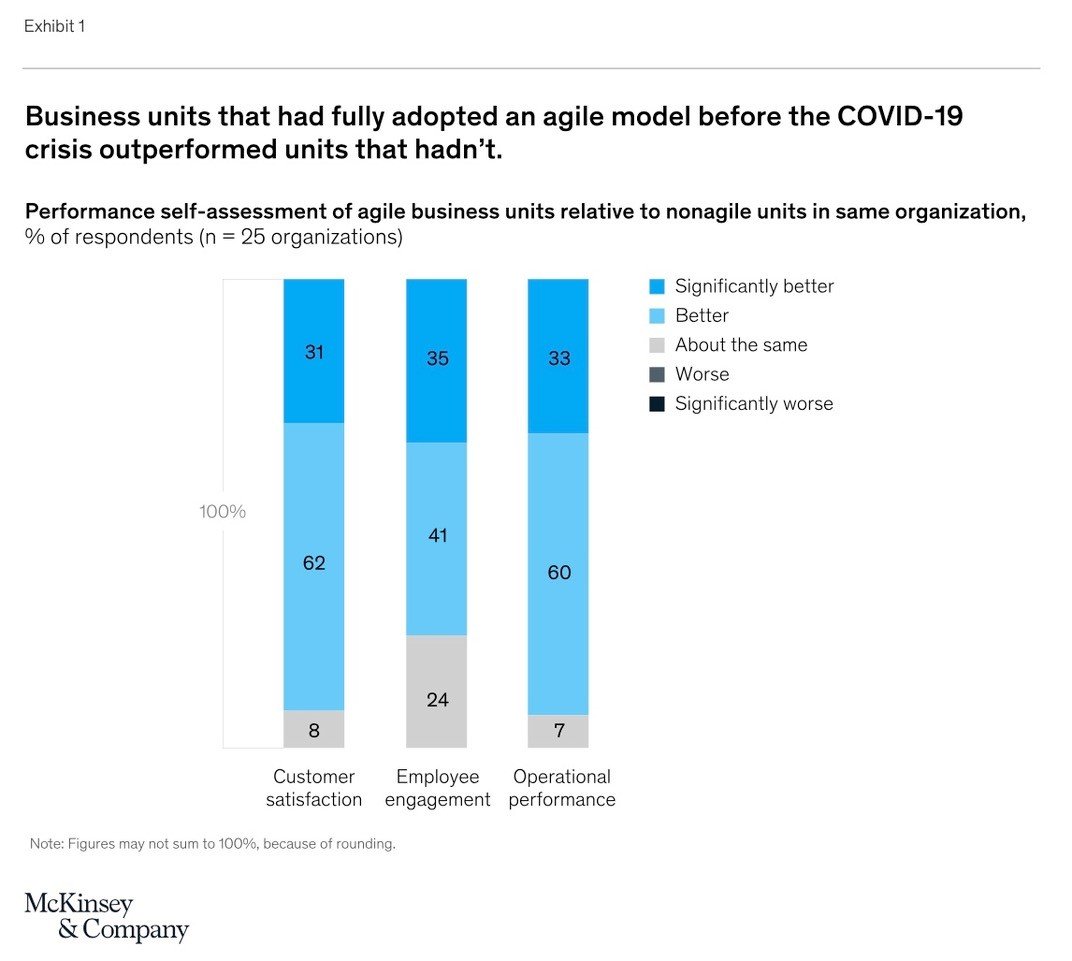
What Does 'Being Agile' Mean?
Agile is the ability to create and respond to change. It is a way of dealing with, and ultimately succeeding in, an uncertain and turbulent environment.The Agile Alliance
What is involved in an Agile Transformation?
A comprehensive Agile transformation touches every facet of the organisation, including people, processes, strategy, structure and technology McKinsey


Every Agile transformation should be different but there are common key success factors found in organisations who have become Agile and that can be modelled, applied and replicated. Three key concepts are:
Top Down - Leading from the top
Ideally Agile transformations will be led by a coalition of C-suite executives with the support of the board. Every part of the business will be impacted by the transformation and so it is key for senior stakeholders to understand what Agile is, to understand what the end state will mean for them and to take an active role in their ongoing support.
Bottom Up - Embracing the change already taking place.
It is also important to recognise and to embrace pockets of existing agility within the firm. It is often the case, especially in larger organisations, that teams will already have dabbled to a greater or lesser extent in Agile frameworks and working practices. These are the potential champions of the future whose energy, enthusiasm and drive can be harnessed as they spread the word of successful team transitions and inspire others to start on the journey.
A great example of this is Microsoft who transformed a single team in 2008, several teams by 2009, around 25 teams in 2010 then several hundred teams by 2011. A commitment for companywide transformation followed around 2014.
Recognition and drive from the bottom up also mitigates the risk of the "being done to" mentality which inevitably leads to resistance and sometimes resentment.
Establishing Small Cross Functional, dedicated and self organising teams.
Agile teams typically comprise of between 5-10 individuals that have the correct mix of skills and tooling necessary to take change from inception to implementation. By encapsulating the entre lifecyle of a change within an individual working unit, the handoffs and intra team dependencies dissolve. Combine this with a reduction in bureaucracy, a level of testing automation and you have a team that can deliver business value at pace. When you empower competent and talented teams to self-organise you create a space for creativity and innovation and with it a lively, exciting and vibrant working environment.
What are some of the pitfalls?
While many traditional heavyweights have embarked on agile transformations, most have faced real challenges in achieving their desired objectivesMcKinsey

With any large scale transformation, there are dangers and common pitfalls. Some of the more common challenges we have seen are:
No clearly defined end state vision
With a comprehensive Agile transformation that can scale across an organisation, comes the need for a new form of operating model that supports and facilitates the Agile Framework. From the outset a clear vision of this operating model and a roadmap to achieve it need to be in place.
Management buy in
Without senior management buy in and a full understanding of the consequences of individual team empowerment, Agile transformations often fail. Grassroot adoption of Agile is common place today but without support from leadership teams this will only ever be sporadic and will never achieve it's true potential.
Creating an Ops model where resourcing is not dedicated
A common misunderstanding when shaping a new operating model is that resources can be shared between teams. When this happens the Agile framework quickly becomes ineffectual and the valuable insights used in planning cannot be created. In order to move at pace, small Agile teams need to be dedicated to a single backlog of work. They need to be able to draw upon their own talent pool, on demand, in order to achieve the commitments they make for a particular sprint.
Role Conversion
Probably the most important aspect of an Agile transformation is ensuring the successful transition of the organisations talent to a new way of working. The people aspect of a transformation can and often is overlooked. The all too common conversations with Project Managers who are abruptly told they are now Scrum Masters and Business Analysts that they are now…emmm… team members? is managed badly and can often lead to disillusionment and a feeling of loss of professional identity. Having clearly defined roles and a transition plan to merge out of an existing structure and into new one is essential and requires forethought, insight and sensitivity.
How we can help?

Clearly Agile can partner with your organisaiton to help ensure the success of either an inflight transformation or, at the outset, in the planning stages to set the foundations from which to build upon. It is essential that each element of change on the roadmap makes sense for the individual organisation undertaking it. Clearly Agile will use it's extensive experience to and help your organisation transition to Being Agile.
